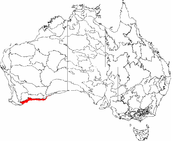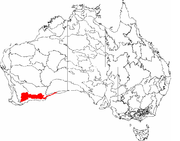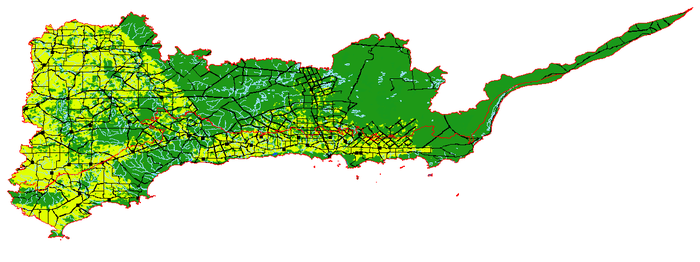
Esperance mallee
Encyclopedia


World Wide Fund for Nature
The World Wide Fund for Nature is an international non-governmental organization working on issues regarding the conservation, research and restoration of the environment, formerly named the World Wildlife Fund, which remains its official name in Canada and the United States...
ecoregion
Ecoregion
An ecoregion , sometimes called a bioregion, is an ecologically and geographically defined area that is smaller than an ecozone and larger than an ecosystem. Ecoregions cover relatively large areas of land or water, and contain characteristic, geographically distinct assemblages of natural...
on the south coast of Western Australia
Western Australia
Western Australia is a state of Australia, occupying the entire western third of the Australian continent. It is bounded by the Indian Ocean to the north and west, the Great Australian Bight and Indian Ocean to the south, the Northern Territory to the north-east and South Australia to the south-east...
, a coastal strip where the predominant vegetation consists of short eucalyptus
Eucalyptus
Eucalyptus is a diverse genus of flowering trees in the myrtle family, Myrtaceae. Members of the genus dominate the tree flora of Australia...
trees and shrubs.
Location and description
Part of the Mediterranean forests, woodlands, and scrubMediterranean forests, woodlands, and scrub
Mediterranean forests, woodlands, and scrub biome, defined by the World Wildlife Fund, characterized by dry summers and rainy winters. Summers are typically hot in low-lying inland locations but can be cool near some seas, as near San Francisco, which have a sea of cool waters...
biome
Biome
Biomes are climatically and geographically defined as similar climatic conditions on the Earth, such as communities of plants, animals, and soil organisms, and are often referred to as ecosystems. Some parts of the earth have more or less the same kind of abiotic and biotic factors spread over a...
Esperance mallee is an aggregation of the Esperance Plains
Esperance Plains
Esperance Plains, also known as Eyre Botanical District, is a biogeographic region in southern Western Australia. Located on the south coast between the Avon Wheatbelt and Hampton regions, and bordered to the north by the Mallee region, it is a plain punctuated by granite and quartz outcrops and...
and Mallee region
Mallee (biogeographic region)
Mallee, also known as Roe Botanical District, is a biogeographic region in southern Western Australia. Located between the Esperance Plains, Avon Wheatbelt and Coolgardie regions, it has a low, gently undulating topography, a semi-arid mediterranean climate, and extensive Eucalyptus mallee...
s of the earlier Interim Biogeographic Regionalisation for Australia
Interim Biogeographic Regionalisation for Australia
The Interim Biogeographic Regionalisation for Australia is a biogeographic regionalisation of Australia developed by the Australian Government's Department of the Environment, Water, Heritage and the Arts...
(IBRA) study.
Flora
MalleeMallee (habit)
Mallee is the growth habit of certain eucalypt species that grow with multiple stems springing from an underground lignotuber, usually to a height of no more than ten metres...
is a generic term to describe a number of eucalyptus trees that have an underground bulb called a lignotuber
Lignotuber
A lignotuber is a starchy swelling of the root crown possessed by some plants as a protection against destruction of the plant stem by fire. The crown contains buds from which new stems may sprout, and a sufficient store of nutrients to support a period of growth in the absence of...
attached to the roots from which new buds can sprout following a forest fire. Mallee trees and accompanying shrubs are thus adapted to the poor soils, lack of rainfall and regular fires of this dry coast.
Fauna
Wildlife of the coast includes the highly poisonous Common Death AdderCommon Death Adder
The Common Death Adder , is a species of Death Adder native to Australia. It is one of the most venomous land snakes in Australia and the world. Unlike its sister species of Death Adders, the Common Death Adder is common and is not under major threat.-Description:Common Death Adders have broad...
. Mammals include tiny Honey Possum
Honey Possum
The honey possum or tait, its Native Australian name or noolbenger is a tiny Australian marsupial weighing just seven to eleven grams for the male, and eight to sixteen grams for the female—about half the weight of a mouse. Their physical size ranges from a body length of between 6.5 –...
s (which feed on nectar of the kangaroo paw
Kangaroo paw
Kangaroo paw is a common name for a number of species, in two genera of the family Haemodoraceae, that are endemic to the south-west of Western Australia. These perennial plants are noted for their unique bird attracting flowers...
flowers), and the endangered Western Quoll
Western Quoll
The western quoll , also known as the chuditch or western native cat, is a medium sized predator and like its eastern and northern relatives, has a white-spotted brown coat and a long tail. It is most closely related to the eastern quoll from which it differs in possessing a first toe on the...
. Birds include the endangered Western Whipbird
Western Whipbird
The Western Whipbird is a passerine bird found in several scattered populations across southern Australia. It is predominantly olive green in colour....
, Western Ground Parrot
Western Ground Parrot
The Western Ground Parrot is an endangered species of parrot endemic to Western Australia and is a close relative of the Eastern Ground Parrot and the somewhat more distantly related and mysterious Night Parrot...
s, Red-winged Fairywren, Australian White Ibis
Australian White Ibis
The Australian White Ibis , is a wading bird of the ibis family Threskiornithidae. It is widespread across much of Australia...
and the rare Southwestern Cape Barren Goose on the coast.
Threats and preservation
Much of the area is used as agricultural land and habitats are threatened by clearance leading to fragmentation, over-irrigation, and wildlife is vulnerable to introduced species such as foxes.
Further reading
- Thackway, R and I D Cresswell (1995) An interim biogeographic regionalisation for Australia : a framework for setting priorities in the National Reserves System Cooperative Program Version 4.0 Canberra : Australian Nature Conservation Agency, Reserve Systems Unit, 1995. ISBN 0642213712

